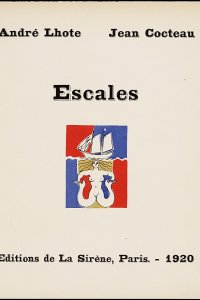Escales
Year: 1920
Author: Jean Cocteau (1889 - 1963)
Design: Louis Kaldor (printer) Atelier Marty (pochoirs)
Artist: André Lhote (1885 - 1962)
Publisher: Editions de la Sirène
In this book, the colourful illustrations are accompanied by a striking typography, made possible by the method that Cocteau said he used. He would have loved to use the type that he knew from the children's books published by Mame at Tours, but the printing workshop of Escales did not have this type. His solution was as follows: 'Once I have photographically reproduced the text of a children's book, cut out the letters, pasted them side by side and then reproduced them again'.
Bibliographical description
Description: Escales / [ill.] Andre Lhote ; [texte] Jean Cocteau - Paris : Éditions de la Sirène 1920 - [72] p. ; 31 cm
Printer: Louis Kaldor, Parijs
Edition: 440
This copy: No. 25 of 400 on vélin pur fil Lafuma ; No. 346 of 400 on vélin pur fil Lafuma (bound by G. Crès)
Bibliography: Carteret V-51 ; Édouard-Joseph III-394 ; Mahé I-537
Bookbinder: G. Crès
Shelfmark: KW KOOPM A 585 ; KW KOOPM A 586
References
- Frédéric Barbier, Paris, capitale des livres: le monde des livres et de la presse à Paris, du Moyen Âge au XXe siècle. Paris, PUF, 2007
- André Lhote, 1885-1962. Paris, Réunion des musées nationaux, 2003
- Pierre Caizergues, 'Notice', in : Jean Cocteau, Œuvres poétiques complètes. Paris, Gallimard, 1999, p. 1604-1608
- Jean Cocteau, 'Impression', in: Éric de Grolier, Le portique; 2 (1945), p. 1-4
- Jean Cocteau, 'Lettre du 30 août 1918', in Lettres à sa mère; I. Paris, Gallimard, 1989, p. 416-417
- Pascal Fouché, La Sirène. Paris, Bibliothèque de Littérature française contemporaine de l'Université Paris, 1984


![André Lhote, Jean Cocteau, Escales (1920): p. [10]-[11]](/sites/default/files/styles/galerie/public/images/escales_p10-11.jpg?h=8e4722da&itok=Jjb-foI9)
![André Lhote, Jean Cocteau, Escales (1920), p. [51]](/sites/default/files/styles/galerie/public/images/escales-p51.jpg?h=7a269184&itok=4CAOOBLr)
![André Lhote, Jean Cocteau, Escales (1920), p. [12]](/sites/default/files/styles/paragraph_small_no_crop/public/images/escales-p12.jpg?itok=W3aZpP1s)
![André Lhote, Jean Cocteau, Escales (1920), p. [63]](/sites/default/files/styles/galerie/public/images/escales_p63a.jpg?h=7a269184&itok=J9O8wADo)
![André Lhote, Jean Cocteau, Escales (1920), p. [63]](/sites/default/files/styles/galerie/public/images/escales_p63b.jpg?h=fba49d59&itok=zRkud0AE)
![André Lhote, Jean Cocteau, Escales (1920), p. [63], detail](/sites/default/files/styles/galerie/public/images/escales_p63_detail.jpg?h=015054eb&itok=1gg33LqU)